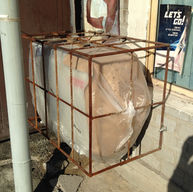Air Conditioners
Air conditioners are not a sexy topic, but this is not a sexy website. It's a site where we ask questions about the world around us, and in Almaty, air conditioners are unavoidable. Nearly every major building in the center of town is hung with these boxes. When I took pictures of architecture, they'd be lingering in the corners of my photographs, and at a certain point I started to wish they'd butt out. They're here to stay, though, and so I figured I better understand what they do and why they dominate this city's facades so aggressively.
I don't know any air conditioning experts, so I turned to the HVAC community on Reddit. Why don't we see these boxes so often back home in the states?, I asked. A bunch of AC nerds weighed in, and they agreed that it has to do with architecture. In the US, buildings are built with a system of ducts that pipes hot and cool air around, but the Soviet-built buildings in Almaty weren't built with anything like that. To keep warm in the winter, the Soviets built a hydronic heating infrastructure, which boiled water in neighborhood substations and then piped the hot water to all the building nearby - radiators then, well, radiated the heat into every room. For cooling, it seems people were out of luck. Most buildings had balconies and that was as sophisticated as things got.
Then the Japanese invented a system called ductless air conditioning, or "mini-split" air conditioning. Kind of like those window-mounted systems you see in big American cities, mini-splits ditched the ducts and giant buzzing rooftop contraptions, and minimized everything into a simple two part system, split up between the actual wind-blowing box inside and a "condensing unit" hanging outside (hence "mini-split"). Mini-splits became popular in Asia, but never took off in America, where "central air" had a strong hold on the market. In the former Soviet Union, though, Asian companies like LG could finally bring A/C to the masses with just two mounting brackets, a condensing unit, and a hose that went through a small hole drilled in the wall.
Now they're a ubiquitous element of Almaty's architecture, something Soviet architects surely never anticipated. Korean logos sit next to hammer-and-sickle moulding, and late-Socialist modular housing blocks, with their drab exteriors and straight seams, are made eclectic by the assortment of AC boxes that have been installed haphazardly over their facades. I've seen some condensing units that have been painted up, which is a nice touch, while others are guarded by wrought-iron bars, looking like they're wild animals caged up. Other times, mounting brackets sit without their boxes, looking kinda lonely. There's surprising variation in the AC world, if you care to pay attention to such mundane things.















